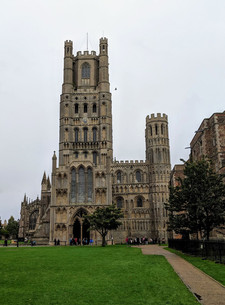6 Day or Weekend Trips from London
- Merrilee MacLean
- Oct 20, 2019
- 5 min read

Most everyone going to England plans to go to London, but what if you have some extra time and want to get away from the big city and explore the countryside a bit. Here are six good options.

York, in northeastern England, is only a two hour train ride from London, though there is so much to do there, it is best to plan to spend a least a few days. York has a rich history going back before the Romans, and has the city walls to prove its important role in the area. It marked the last “civilization” before the “savage” Scots. They have even discovered remnants of Viking settlements, which you can tour in an elaborate (Disney-like) re-creation at the Jorvik Viking Center. The center of York is dominated by the York Minster, which has been the center of Christianity for northern England since the 7th century. Just outside the Minster is a warren of streets including The Shambles, arguably one of the best preserved medieval streets in the world. There is mention of the street in the 1086 Domesday Book, but most of the buildings there now date back to the late 14th and 15th centuries. Indeed, the street was named “Britain’s most picturesque street” by Google Street View Awards. One of the best museums in England is in York – the York Castle Museum, with excellent displays of what life was like in four different centuries and an astounding re-creation of Victorian city streets, manned by volunteers in costumes ready to answer your questions in character. There is also an excellent section on the impact of World War I on the local people and area. You can easily spend several hours there. York can also be an excellent base for touring the nearby Yorkshire Dales (think of James Herriott and All Creatures Great and Small) or the North York Moors and the coastal town of Whitby with its abbey ruins.

Chester is on the other side of the country, near the northern Welsh border, but still only about two hours away by train from London. Voted the fifth prettiest city in Europe (and the prettiest in the U.K.) in a 2013 USA Today poll, it is worth a visit. Initially established as a Roman fortress in the first century (actually 79 A.D.), it is the best preserved walled city in England. Indeed, there is even a Roman amphitheater which is still under excavation. Chester is perhaps best known for its half-timbered buildings and the Rows – an area of two storied covered arcades dating back to the 13th century. Lots of good shopping to be had. The Chester Cathedral is very welcoming and a major tourist attraction. Chester is also a good base to explore northern Wales and the Lake District, just north.
Betws-y-coed is an excellent choice if you are looking for an escape to the countryside for a few days. It is a 4-5 hour trip by train from London, but seems worlds away. A small village in northern Wales, it is an excellent base for hiking and other outdoor activities, with the Snowdonia Activities Center ready to provide advice and routes. The main feature in the town is the Pont-y-Pair Bridge, which spans the Afon Llugwy river right at a series of waterfall/rapids.
The houses are all built of the local blue-gray slate, and there are restaurants, hotels and other tourist features to satisfy any need for a relaxing retreat. Alternatively, it is a good base to explore other areas of Northern Wales including the Ffestiniog Railway, Conwy, and Caernarfon Castle, where the investiture of Charles as Prince of Wales was held.

Closer to London, Cambridge is just an hour north and an easy visit as a day trip, though spending more time will allow the storied walls of academia a chance to soak in. One really does feel smarter just walking the streets. Cambridge University, together with Oxford (the two are often referred to as Oxbridge) has produced most of the influential people in Britain (including its spies) for the past 800 years. Walking around Cambridge, you will see the different colleges, all behind closed gates, the river Cam, which bisects the city and is filled with punters on nice days, and even cows grazing in the fields just across from King’s College. The Chapel of King’s College is extraordinarily beautiful, and if you can, attend the Evensong service to hear the excellent choir. Be sure to stop by The Eagle, a pub just off King’s Parade dating back to 1667, where there is an RAF Bar in the back, with memorabilia and graffiti from the airmen (British and American) that were stationed nearby during World War II, and which is best known for being the place that Crick and Watson first announced that they had “discovered the secret of life” - DNA. Finally, the only American cemetery in England is located just outside Cambridge.
Ely is about 30 minutes from Cambridge, easily reachable by public transport, and can be a day trip from either Cambridge or London. Its focal point, as with York, is the 900 year old Ely Cathedral, which has a unique octagonal lantern tower, glorious high lines in its dome area, a unique painted nave, and even a stained glass museum. You can even climb the 216 foot West tower for an excellent view of the surrounding countryside. Oliver Cromwell lived in Ely, and his house now hosts the Visitor’s Center. The Cathedral is bordered by a spacious park and there is a canal nearby with houseboats. They take their village life seriously, with Harvest Festivals and even the Great Ely Potato Race, where racers carry 44 pound bags of potatoes. If you want to get a feel for English village life, visit Ely.

Royal Tunbridge Wells is just 45 minutes southeast of London and an easy day trip. Tunbridge Wells became a favorite resort for the rich and famous after its waters were determined to be therapeutic for drinking, in 1606. Located within a day’s ride of London, it was an easy place for Londoners to visit and became popular among royals and gentry. Eventually, the muddy walks near the spring were paved with clay tiles baked in a pan – called pantiles. By 1735, Beau Nash (one of the original dandies) created a social protocol, with the “upper walks” limited to only the gentry, leaving everyone else to use the “lower walks.” It was quite the place to be in the 18th and 19th centuries. Indeed, it became so popular with members of the royal family, including Queen Victoria and Albert, that it was given the appellation “Royal” in 1909. The Pantiles are now an area of shops and restaurants, with the “upper” and “lower” designations retained, but no social limitations. It is a lovely area to walk, shop, and linger, with many tempting stores and restaurants. During the summer there are festivals and concerts to entertain visitors. Still, the pace is slower, there is no traffic noise, one can just relax. After a few hectic days in London, Tunbridge Wells might be just the ticket for an escape.
#londondaytrips #londonweekendtrips #londongetaways #york #yorkminster #yorkshambles #yorkcastlemuseum #chester #chestervisit #wales #welshtravel #betwsycoed #snowdonia #pontypair #cambridge #cambridgepunting #kingscollege #kingcollegechapel #kingscollegechapelevensong #ely #elycathedral #visitely #cambridgeshire #tunbridgewells #pantiles #royaltunbridgewells #grownuptraveler #grownuptravels #wanderlust #britishtravel



















Comments